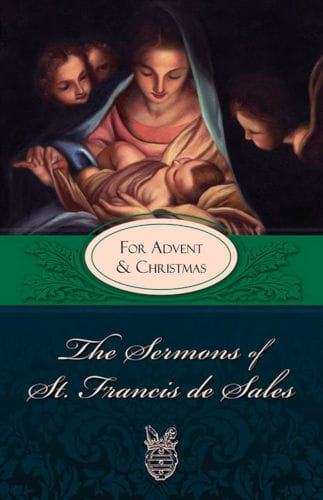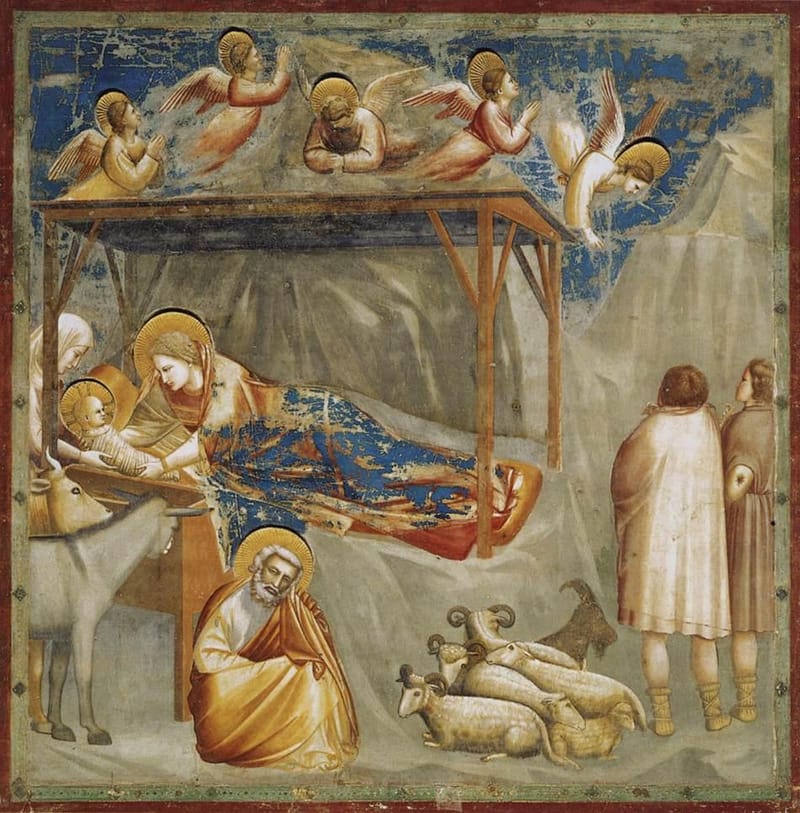“Next to the yearly celebration of the Paschal Mystery [Easter], the Church holds most sacred the memorial of Christ’s birth and early manifestations. This is the purpose of the Christmas season.” Ceremonial of Bishops 234.
So sacred is Christmas that the Church dedicates a period of spiritual preparation for it. "Advent has a twofold character, for it is a time of preparation for the Solemnities of Christmas, in which the First Coming of the Son of God to humanity is remembered, and likewise a time when, in remembrance of this, minds and hearts are led to look forward to Christ’s Second Coming at the end of time. For these two reasons, Advent is a period of devout and expectant delight.” Universal Norms on the Liturgical Year and Calendar 39.
However, it is easy to caught up in the external celebration of the feast and its preparation. As a result, we are often distracted from the main point of Advent and Christmas: a deepening of our spiritual life and union with the Incarnate Word. Dedicating some time to spiritual reading becomes especially important, therefore, during Advent and Christmas. Here, then are some books that may help you during these liturgical seasons.
- Jesus of Nazareth, Volume 3: The Infancy Narratives
by Benedict XVI - The Sermons of St. Francis de Sales: For Advent and Christmas
by St. Francis de Sales - The True Meaning of Christmas: The Birth of Jesus and the Origins of the Season
by Michael Barber - The Nativity Scene
by Eduardo de Filippo - Illuminating Luke: The Infancy Narrative in Italian Renaissance Painting
by Heidi J. Hornik and Mikeal C. Parsons
In no way, is this list meant to be the last word. There are plenty of fine books that are worth reading during Advent and Christmas. So, take this list for what it is: a selection of some books that may help you get more out of these liturgical seasons.
As with the lists for Lent and Easter, this one gives priority to books that connect the feast with Scripture, the Church Fathers, the liturgy, the Church’s spiritual tradition, and sacred art.
Moreover, Christmas is a time for song and feasting. Stay posted for lists of recommended Christmas recordings and gastronomy guides.
“My hope is that this short book, despite its limitations, will be able to help many people on their path toward and alongside Jesus.” Benedict XVI

1.
The first volume of Benedict XVI’s Jesus of Nazareth topped the list of recommended books for Lent; the second volume, the lists for Holy Week and Easter. It is appropriate, if only for the sake of consistency, that the third volume, The Infancy Narratives, top the Christmas list.
One motive for including Jesus of Nazareth in this year’s seasonal lists was to honour the recently deceased Pope emeritus. Still, that would not have been reason enough. The main reason for including them was that they guide us through the main Gospel passages of the liturgical season. The same is true of The Infancy Narratives.
Chapter Two is on the two Annunciations: that of the birth of John the Baptist and that of the birth of Jesus. This chapter is suitable spiritual reading for Advent.
Chapter Three covers the event celebrated on December 25; Chapter Four, those commemorated on January 6.
As in the other volumes of his Jesus of Nazareth trilogy, Benedict XVI aims to explain the God by bringing together traditional and modern exegesis into a new synthesis. He seeks to interpret the Gospel “in dialogue with exegetes past and present.” However, the work is never dry or excessively academic. As Benedict XVI notes, the interpretation of Holy Writ cannot restrict itself to establishing the meaning originally intended by the human author. God is the principal author of Scripture and he addresses himself to us in our situation. Hence, a complete interpretation of the Scripture must also explain how the text concerns me, here and now. Benedict XVI is mindful of this and that makes his Jesus of Nazareth the exegesis of a true shepherd.

2.
Many hope that one day Benedict XVI will be declared a doctor of the Church, and what more authoritative guide through Advent and Christmas is there than a doctor of the Church.
Saints Augustine, John Chrysostom, Leo, and Bernard are among the doctors who have left magnificent homilies for Advent and Christmas. St. Francis de Sales is another. TAN Books’s collection of eight of his homilies for the season makes for excellent Christmastide spiritual reading.
The first three homilies were given on the last three Sundays of Advent and focus on St. John the Baptist, the precursor who figures so prominently through the season and invites us to prepare for the Lord’s coming. The other five are on Christmas feasts.
Though a doctor of the Church, St. Francis de Sales does not crop up much in textbooks of theology. Today, he is best known today for his Introduction to the Devout Life, a classic of Catholic spirituality. This might lead some to assume that his homilies on Advent and Christmas are simply invitations to imitate the virtues of the Child Jesus, Mary, Joseph, and John the Baptist. They do contain this kind of spiritual teaching but much more besides. Over the course of the homilies St. Francis explains the fundamental mysteries of the faith, such as the Trinity, the Incarnation, and the Eucharist. He draws on the liturgy, the Church Fathers, and the whole of Scripture. With their depth and sweep, these sermons are a model of substantive preaching. They show why St. Francis de Sales is deservedly a doctor of the Church.
“Advent has a twofold character, for it is a time of preparation for the Solemnities of Christmas, in which the First Coming of the Son of God to humanity is remembered, and likewise a time when, in remembrance of this, minds and hearts are led to look forward to Christ’s Second Coming at the end of time. For these two reasons, Advent is a period of devout and expectant delight.” Universal Norms on the Liturgical Year and Calendar 39.

3.
In some regards, the next recommended book resembles Benedict XVI’s The Infancy Narratives. Like it, Michael Barber’s The True Meaning of Christmas draws on both traditional and modern exegesis to unpack the Gospel’s account of Christ’s birth. At the same time, it goes into more detail about how Jesus, with his birth, is fulfilling many of the events, institutions, and prophecies from the Old Testament.
Although the book is full of scholarship, it is brief, to the point, and accessible to the general reader.
Nor does it simply report the results of biblical exegesis. Chapter 11 looks at the historical grounds for the Church’s decision to celebrate Christ’s Nativity on December 25. Chapter 12, on the other hand, presents the history and significance of many of the non-biblical trappings of Christmas, such as Christmas trees and Santa Claus.
By explicating the Gospel narratives of Christ’s birth, the liturgical calendar of Christmas, and other festive traditions, this book helps us rise above the secularising and commercial takeover of the feast and retrieve the true meaning of Christmas.
“The solemnity of the Lord's birth celebrates the mystery of the Incarnation by which the Word of God humbled himself to share in our humanity, in order that he might enable us to become sharers in his divinity.” Ceremonial of Bishops 237

4.
The Christmas holidays are also a time for rest and relaxation. Avid readers may be looking forward to a relaxing afternoon by the fireplace, with a mug of hot chocolate in one hand and a good book in the other, ideally a work of fiction with a Christmas setting.
There is not much point in recommending well-known books that you have probably read already, such as Dickens’s A Christmas Carol or O. Henry’s “The Gift of the Magi.” A relatively unknown author and work makes for a more intriguing, useful recommendation.
Take for example The Nativity Scene (Natale in casa Cupiello, literally Christmas at the Cupiellos) by the Neapolitan playwright Eduardo De Filippo (1900-1984).
De Filippo was a theatrical jack-of-all-trades—actor, empresario, director, writer—and is considered one of the most important Italian twentieth-century playwrights. Though he was nominated for the Nobel Prize for Literature, he is little known among English readers.
What Pirandello is to Sicily, De Filippo is to Naples. Most of his works, including The Nativity Scene (1931), are set in his hometown and use a literary version of the local dialect. This is not an obstacle for non-locals. Rather it allows De Filippo to give universal human problems a concrete setting.
As with most of his plays, the protagonist of The Nativity Scene is put upon by the rest of the family, suffers misfortune, yet bears it with dignity. The title of the English translation refers to one of the play’s central plot elements: the Nativity Scene that Luca, the good-natured yet bungling head of the Cupiello family, prepares each year with enthusiasm. With this custom, Luca behaves as a typical Neapolitan. The city is arguably the world capital of presepi and making picturesque Nativity scenes is a popular local tradition. However, this plot element takes on a deeper meaning. As Kevin Z. Moore puts it in his excellent introduction to the English translation, “The play’s iconic center, the presepe or crib, symbolizes the father’s desire for social reconstruction, which can only begin with the primary social unit, the family.”
The Nativity Scene is not the only symbolic element in the play. Some of the characters share not both the name and characteristics with a figure from the Gospel. Not by chance Luca is named after the Evangelist who gives most of the details about the Nativity. Luca’s deadbeat, sceptical son is called Tommasino. His patron saint is the doubting apostle.
The Nativity Scene is not a cosy, sentimental Christmas tale but a tragicomedy. On the one hand, it is the story of a family troubled by the vices and hard-heartedness of some members. On the other hand, it ends on an ambivalent note, leaving it for the reader to decide whe therthe Christian faith is true or merely a comforting delusion. With these disconcerting features, the work is a salutary reminder of the kind of world in which the Word became flesh and that he came to save.

5.
For the final book, we stay in Italy and its artistic representation of the Nativity.
Heidi J. Hornik, an art historian, and Mikeal C. Parsons, a New Testament scholar, are the authors of the three-volume Illuminating Luke.
As Hornik and Parsons point out in the introduction, many of the greatest works of art depict scenes from Scripture but lose much of their intended context when they are viewed in museums rather than within places and rites of Christian worship. Consequently, they aim to help the reader retrieve much the Christian meaning of such art.
They focus on Renaissance paintings of Luke because this is an area in which their respective fields of specialization converge.
The first volume looks at some Italian Renaissance depictions of the Nativity narrative. It focuses on four paintings: Leonardo Da Vinci’s The Annunciation; Jacopo Pontormo’s The Visitation; Domenico Ghirlandaio’s The Nativity and the Adoration of the Shepherds; Ambrogio Lorenzetti’s The Presentation in the Temple.
Through its fascinating and instructive commentary, the book not only discloses much of the meaning of these works but can also prepare us to contemplate more carefully the sacred art with which we pray during this year's Christmastide .
These, then are five books that might help us prepare for Christmas, enter more deeply into the mystery of Our Lord's first coming, and make ourselves ready for when he comes again in glory.





